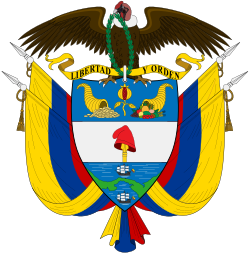This article includes a list of references, related reading, or external links, but its sources remain unclear because it lacks inline citations .(May 2024) |
Republic of New Granada | |||||||||
|---|---|---|---|---|---|---|---|---|---|
| 1831–1858 | |||||||||
| Motto: Libertad y Orden (English: Liberty and Order) | |||||||||
| Anthem: Al Veinte De Julio (Spanish) | |||||||||
 Republic of New Granada | |||||||||
| Capital | Santa Fé de Bogotá | ||||||||
| Religion | Roman Catholicism | ||||||||
| Demonyms |
| ||||||||
| Government | Unitary presidential republic | ||||||||
| President | |||||||||
• 1831 | Domingo Caycedo | ||||||||
• 1832-1837 | Francisco de Paula Santander | ||||||||
• 1857–1858 | Mariano Ospina Rodríguez | ||||||||
| History | |||||||||
• Established | 20 October 1831 | ||||||||
• Bill of rights 1 | 1853 | ||||||||
• Constitutional Change | 11 April 1858 | ||||||||
| Area | |||||||||
• Total | 1,331,250 km2 (514,000 sq mi) | ||||||||
| Population | |||||||||
• 1851 | 2,243,730 | ||||||||
| Currency | Peso | ||||||||
| |||||||||
| History of Colombia | ||||||||||||||||||||
|---|---|---|---|---|---|---|---|---|---|---|---|---|---|---|---|---|---|---|---|---|
 | ||||||||||||||||||||
| Timeline | ||||||||||||||||||||
| ||||||||||||||||||||
The Republic of New Granada was a centralist unitary republic consisting primarily of present-day Colombia and Panama with smaller portions of today's Costa Rica, Ecuador, Venezuela, Peru and Brazil that existed from 1831 to 1858. The state was created after the dissolution of Great Colombia in 1830 through the secession of Ecuador and Venezuela. In 1858, the state was renamed into the Granadine Confederation. On 9 May 1834, the national flag was adopted and was used until 26 November 1861, with the Gran Colombian colours in Veles' arrangement. The merchant ensign had the eight-pointed star in white.

